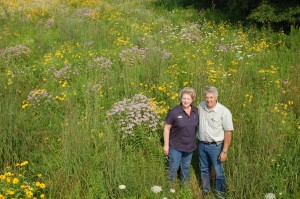
Michigan landowners, Paul and Becky Rogers, used a USDA conservation program to convert 14 acres of land in Kent County to a pollinator habitat that is home to more than 50 species of wild bees that supplement fruit and vegetable pollination in the state’s fruit ridge.
By: Brian Buehler, Natural Resources Conservation Service, Public Affairs Specialist
Paul and Becky Rogers enjoy much more than flowers on their land in Kent County after converting 14 acres to native pollinator habitat eight years ago through the USDA Farm Service Agency (FSA) State Acres for Wildlife Enhancement (SAFE), part of the Conservation Reserve Program (CRP).
After learning that the SAFE program helps landowners establish diverse grassland and pollinator habitats, the Rogers were immediately interested.
The SAFE native pollinator component targets the two tiers of counties along Lake Michigan in the Lower Peninsula to support native pollinators that supplement fruit and vegetable crop pollination, usually provided by commercial honeybees.
As wildlife and nature enthusiasts, the SAFE program was a natural fit for the Rogers’ land, which is in close proximity to the state’s fruit ridge, an agricultural area approximately eight miles wide and 20 miles long northwest of Grand Rapids, known for fruit and vegetable production.
Landowners who participate in the SAFE native pollinator initiative receive cost-share assistance of up to 90 percent of the cost of converting cropland to pollinator habitat. Participants also receive annual rental payments for the duration of the 10 to 15 year contract. Since 2007, Michigan farmers have converted more than 1,700 acres of cropland to pollinator habitat through the SAFE initiative.
Today, the two fields the Rogers planted with native flowers and grasses support not only native pollinators but also a variety of song birds and other wildlife including deer, which is a bonus for Paul who enjoys hunting.
“This has really been a great program for us and we are very happy with the way it has worked on our land,” said Paul. “The SAFE acres provide excellent wildlife viewing opportunities. The tall grasses hold back the winter snow and provide shelter for wildlife.”
Four years ago, a graduate student from Michigan State University Department of Entomology did a survey of the Rogers’ pollinator habitat along with several other SAFE pollinator plantings in Michigan. The researcher identified 53 wild bee species on the SAFE plantings from 18 different genera.
Not surprisingly, the study found a much greater abundance and variety of wild bees in the pollinator habitats than in surrounding crop fields.
Of the 99 bees captured on the Rogers’ land, 40 percent were native wild bees with Leafcutter and sweat bees being the most abundant. A large number of honeybees were also found in greater abundance than in surrounding fields.
The Rogers’ SAFE acres bloom from mid-June until the first hard frost.
With the decline in honeybee populations over the past few years, partly due to Colony Collapse Disorder (CCD), the protection and creation of pollinator habitats is increasingly important to ensure adequate pollination of agricultural crops.
“I truly believe that establishing pollinator habitat is a win-win by providing excellent wildlife habitat and an abundance of native and non-native pollinators that benefit Michigan fruit and vegetable agriculture,” said Paul.
CRP is among the largest private lands program for conservation used to reduce soil erosion, improve water and air quality and provide wildlife habitat. CRP is a voluntary program that allows eligible landowners to receive annual rental payments and cost-share assistance to establish long-term, resource-conserving covers on eligible farmland throughout the duration of the10 to 15 year contract.
Since being established on December 23, 1985, CRP has helped prevent more than 8 billion tons of soil from eroding and protected more than 170,000 stream miles with riparian and grass buffers, more than 100,000 acres of bottomland hardwood trees, nearly 300,000 acres of flood-plain wetlands, and 250,000 acres each for duck nesting habitat and upland bird habitat.
2015 marks the 30th Anniversary of CRP. For an interactive tour of CRP success stories from across the U.S., please visit the FSA CRP 30th Anniversary website at http://www.fsa.usda.gov/CRPis30.
To find your local USDA Service Center, please visit http://offices.usda.gov.





